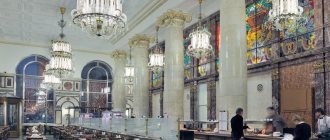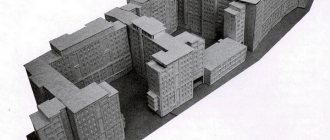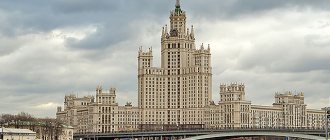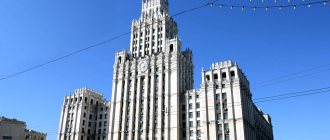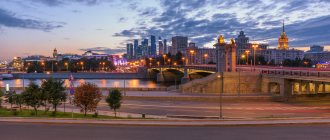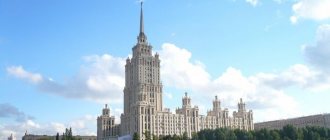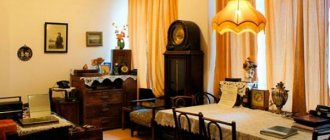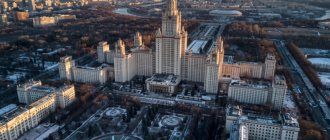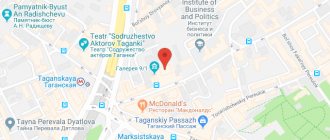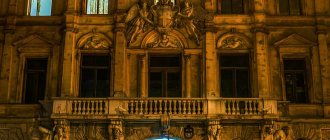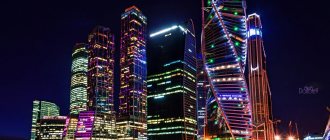Where is the high-rise, location in the city
The high-rise is located at the confluence of the river. Yauza in the river Moscow, where Kotelnicheskaya and Podgorskaya embankments intersect. The exact address of this monumental building is Kotelnicheskaya embankment 1/15.
The main Moscow attractions are within walking distance from the building:
- Red Square;
- Kremlin;
- Cathedral of Christ the Savior;
- Tretyakov Gallery.
The nearest metro stations are:
- Taganskaya (purple branch);
- China Town (purple and orange lines).
Several urban ground transport routes pass by the house on Kotelnicheskaya Embankment.
High-rise in culture
- In the 2006 novel “Moscow Kva-Kva” by Vasily Aksenov, the main character of the novel, 19-year-old Moscow State University student Glika Novotkannaya, lives with her family in a house on Kotelnicheskaya Embankment. Here, according to the author’s plan, there is a secret refuge where Stalin dies[46].
- The high-rise building is mentioned in Lyudmila Ulitskaya’s novel “Medea and Her Children.” A character in the novel tries to commit suicide after “a young girl, the daughter of a famous aircraft designer, jumped from the seventh floor.”[47]
- There are lines about the building in Garik Sukachev’s song “Night Flight”[48]:
And when the fear recedes, for a second, in a short moment, I will soar on wings over the boulevard and high-rise. And, flying over the Yauza, whistling loudly at the top of my lungs, I will fly in an arc, jokingly - in the black night, by the way...
- In the film “Pokrovsky Gate”, Oleg Menshikov’s character came to the building on Kotelnicheskaya Embankment to meet the parents of the girl he loved[18].
- The building also appeared in the films “Moscow Doesn’t Believe in Tears”, “Brother-2”, “Hipsters” and in the TV series “Brigade”[10].
- In the film “Moscow Secrets. Seven Sisters” the action takes place around an apartment in a building on Kotelnicheskaya Embankment.
How a residential building was built on Kotelnicheskaya Embankment
The idea of replacing the pre-revolutionary architectural dominants of Moscow with new ones, reflecting the greatness and historical significance of the Soviet regime, appeared among party leaders already in the early 20s. last century. This decision finally found its place in the plan for the reconstruction of Moscow, developed in 1935.
In accordance with the plan, 8 high-rise buildings were to be erected in the central area of the capital , the main one of which was the 400-meter Palace of the Soviets. The unique building was planned to be erected opposite the Kremlin. The Soviet colossus was never built, but 7 less ambitious projects were soon brought to life.
The high-rise building on Kotelnicheskaya Embankment was the first completed building made in the Stalinist Empire style.
Its history begins in the mid-30s, when a competition was announced among metropolitan architects to develop a project for the construction of a building on the spit between the Yauza and Moscow rivers.
The idea developed by the famous architect Dmitry Chechulin in collaboration with Andrei Rostkovsky was recognized as the best. The building they proposed consisted of 3 buildings, the tallest of which had 24 floors.
The implementation of the project began in 1938. In 2 years, a 9-story building was erected, the facade of which overlooked the Moscow River embankment. They returned to the implementation of grandiose plans after the end of the war.
The skyscrapers, embodying the power of the Soviet state, were laid on the day of the celebration of the 800th anniversary of the founding of the capital - September 7, 1947. Together with other construction projects, the construction of the main (B) and side (C) buildings on Kotelnicheskaya Embankment began.
This was the first time such construction had been carried out in this area, so emerging problems and issues were resolved during the construction process.
The following events resulted from the work on Stalin’s skyscrapers:
- Development of powerful deep foundations, allowing the construction of massive buildings on loose and soft metropolitan soils. They occupied a large share of the funds allocated for construction.
- The lack of necessary technical equipment contributed to the development of the construction industry. New factories for the production of building materials (reinforced concrete slabs, ceramic stones and lightweight bricks) were erected, and construction equipment was developed that had the ability to independently rise to the top as the building was being built.
- The party leadership demanded that iconic buildings be built in record time. The rapid pace of construction was maintained by using the labor of prisoners and prisoners of war. From 1948 to 1953 At the construction site at the confluence of the capital's rivers, there was a camp for male and female construction prisoners. The fact that their labor was used is confirmed by the memories of the first residents of the elite new building, who saw bars and inscriptions on the windows about the construction of a certain room by a certain detachment. Subsequently, many architectural and engineering construction projects throughout the country were erected by people imprisoned in the camps.
The settlement of the high-rise buildings began in 1953. Distribution began during construction and was supervised by the head of the NKVD L. Beria. The last word remained with the head of the party and state, I.V. Stalin. These circumstances explain the rather original composition of the first residents of the house, located in close proximity to the Kremlin and Lubyanka Square.
In general, the following pattern in settlement is visible:
- In building A (the first building built on the Moscow River embankment) security officers, representatives of the Ministry of Internal Affairs and senior army officials lived.
- Building B (the central high-rise part) was inhabited by scientists representing various scientific fields that were a priority for the state. Nuclear scientists, chemists, aircraft designers, and historians lived here.
- The building of building B (the façade of the building faces the embankment of the Yauza River) was inhabited by representatives of the Soviet creative intelligentsia, which included artists, writers, sculptors, and architects.
The history of the high-rise building on Kotelnicheskaya Embankment in Moscow
High-rise buildings in Moscow began to be built after the Great Patriotic War, although skyscraper projects appeared back in the 1920s. The plan for the construction of eight high-rise buildings, approved by I.V. Stalin, was adopted by the Council of Ministers of the USSR in January 1947. In the same year, all buildings were officially laid down. The construction of such structures has become a challenge for domestic engineers and industry. There was no experience or technology for constructing skyscrapers in the country; we had to learn and create new production facilities right in the process.
The authors of the high-rise building on Kotelnicheskaya Embankment were architects Dmitry Chechulin and Andrey Rostkovsky. Their project won the competition and was included in the General Plan for the Reconstruction of Moscow in 1935. Even then, the house plan included three buildings, although the height was lower - only 24 floors. The first building along Kotelnicheskaya Embankment was built before the war (in 1938-1940). Then the expensive construction was frozen and returned to it in 1947 as part of the Stalinist high-rise project. They worked on the central and second buildings for 4 years (from 1948 to 1952).
View of the high-rise building on Kotelnicheskaya embankment, © Alexander Selifanov
Architecture
The high-rise building on Kotelnicheskaya Embankment is an L-shaped building consisting of three buildings. The multi-storey stepped building organically fits into the existing architectural style of the capital. The side buildings are rectangular structures, and the shape of the middle building resembles a three-pointed star.
One of its rays faces the western slope of Tagansky Hill, and the other two are adjacent to the side buildings. The number of floors in the side parts ranges from 8 to 10.
The main building, which according to the original plan was supposed to consist of 16 floors, doubled in size by the end of construction. It has 26 residential and 6 technical levels. In general, its height, together with the spire ending in the shape of a star, is 176 m.
The external and internal decoration of the building is made in the Stalinist Empire style, combining features of classicism, baroque, neo-gothic and art deco. The facades of the building are decorated with powerful protruding cornices and blades. The central building up to the 5th floor is lined with pink marble, which creates the illusion of the presence of a powerful high base.
On the facades of all parts of the building there are multi-figure bas-reliefs depicting Soviet people in simple work clothes. Also in their composition there are many figures of children and young people holding in their hands the symbol of peace - a dove.
It should be noted that the sculptural groups of cone B are made with almost portrait accuracy. The figures of the side parts are poorly polished and are angular. The roof of the building is decorated with numerous balustrades, turrets, spiers and monumental sculptural compositions.
The interiors of the premises were decorated with marble, valuable wood species and expensive non-ferrous metals . The walls and ceilings are decorated with paintings, bas-reliefs and stucco moldings.
In addition to the above-ground parts, the building had a spacious underground parking lot that could accommodate more than 200 cars. The architectural complex included a landscaped courtyard with lush flower beds, fountains and asphalt paths.
High-rise building No. 2 – on Red Gate Square
A residential building in the “Stalinist Empire” style on the Garden Ring near Red Gate Square was erected by architects B. Mezentsev and A. Dushkin. The height of the building was 138 m, which is not much compared to other Stalinist skyscrapers.
The architects obtained from the city authorities the right to place the house on the highest section of the Garden Ring, which made the building impressive.
The house, which combines residential and administrative premises, was built during 1949–1953. The Stalinist high-rise building on Red Gate Square has 24 floors, and the roof of the building is topped with a tiered tent. The building housed the Ministry of Transport Engineering.
In addition to the ministry, the building houses: the Moscow Interbank Currency Exchange, a bank, the Transstroy corporation, and the Russian Trade Union of Railway and Transport Builders.
It is noteworthy that the building was built at the highest point of the Garden Ring, on Sadovaya-Spasskaya Street, and despite its modest size in comparison with other Stalinist high-rises, it looks quite large and visually can be compared with the 36-story building of Moscow State University.
Address : Moscow, Sadovaya-Spasskaya street, 21.
Metro : station "Red Gate".
Unfortunately, during the construction of the high-rise building, the ancient mansion in which M. Yu. Lermontov was born was demolished. In memory of the poet, from 1941 to 1992, Red Gate Square was called Lermontovskaya.
Infrastructure
The high-rise building on Kotelnicheskaya Embankment is a unique building that embodies the communist idea of a large house-city that will accommodate all the infrastructure necessary for life.
The following organizations were located in the house:
- ordering and consumer services bureau;
- the shops;
- public canteen;
- cinema;
- kindergarten.
Different sources indicate different numbers of apartments (from 350 to 800). All of them were equipped with advanced engineering systems and household appliances at the time of completion of construction.
These include:
- centralized air ventilation system;
- centralized dust removal system;
- boiler heating system;
- personal sewerage in each apartment;
- kitchen sinks with garbage crusher;
- electric refrigerators.
Some advanced for the 50s. solutions today seem like backward ideas:
- There was only one electrical outlet in each room, and there were none at all in the kitchen.
- Both first-time and modern residents note the low level of sound insulation.
- After the high-rise building was put into operation, kitchen garbage chutes became a source of problems. In the 50s from them, hordes of cockroaches entered the living quarters. In modern times, indoor sewage systems are a source of unpleasant odors.
All apartments in building A were connected by doors. There is an opinion that they were made so that security officers could enter any premises around the clock. According to the official version, these passages were made for fire safety purposes. In the other two buildings, all apartments were equipped with a back door that opened onto the courtyard.
High-rise building No. 6 – Leningradskaya Hotel
Among all the Stalinist skyscrapers, the 136-meter Leningradskaya Hotel stands out for its lack of wide buildings and its miniature size. From some angles the building looks like a medieval tower.
Another feature of Leningradskaya is the interior decoration, which is magnificent even by the standards of the Stalin Empire style. The architect L. Polyakov involved specialists in ancient Russian architecture and church architecture in the interior work.
The premises are decorated with expensive marble, crystal, and gems. Inside the building there is a huge number of sculptures, bas-reliefs, mosaics, and forged elements.
Address : Moscow, Kalanchevskaya street, 21/40.
Metro : station "Komsomolskaya".
Since 2008, the hotel has been named Hilton Moscow Leningradskaya, it has 275 rooms, as well as the amenities inherent in any modern five-star hotel in the form of shops, beauty salons, restaurants and swimming pools.
It is worth noting that despite the major renovation of the entire building, the original image and interior of the hotel was preserved, and the facades acquired additional luxury.
What's in the building today?
The high-rise building on Kotelnicheskaya Embankment today remains a prestigious building for living.
Within its walls are located:
- cinema;
- the shops;
- banking and post office;
- kindergarten;
- museums.
It is quite difficult to determine the exact number of modern residential premises, since the owners combine several old apartments into one apartment. The approximate number of apartments is shown in the following table.
| Number of rooms in the apartment | Number of apartments in the building | Total number of residential premises |
| 1 | 13 | 540 |
| 2 | 336 | |
| 3 | 173 | |
| 4 | 18 |
Independent redevelopment of residential premises leads to violation of the integrity of load-bearing structures and utility accidents. One of them, which occurred in January 2021, led to damage to some unique exhibits in the apartment-museum of the ballerina Galina Ulanova.
Residents were seriously concerned about the unauthorized installation of an elevator in multi-level apartments, which led to a violation of the integrity of structures in apartments on the lower floors. A major renovation of the high-rise building, built in 1952 on Kotelnicheskaya Embankment, was not carried out until 2015. For these purposes, more than 3 billion rubles were allocated from the municipal budget.
The repair lasted 2.5 years, during which specialists completed the following work:
- restoration of facades, bas-reliefs and sculptural groups;
- renovation of interior paintings;
- installation of new elevators, ventilation systems, waste disposal and electrical wiring.
During the restoration, the architectural monument of municipal significance was damaged, as the Soviet entrance doors were replaced.
High-rise No. 3 – Ministry of Foreign Affairs building
The first Stalinist high-rise building, commissioned in 1953, several months earlier than the Moscow State University high-rise building. The project of a 172-meter high-rise building was developed by architects M. Minkus and V. Gelfreich.
The original appearance of the high-rise was different from the modern one: the building did not have a spire. Stalin did not like this concept, and he ordered the architects to build a spire. It was extremely difficult to complete the task: the structure created additional load on the upper floors of the building.
Minkus and Geilfreikh erected a lightweight frame spire on the high-rise, too weak to be crowned with a five-pointed star. As a result, the Foreign Ministry building became the only Stalinist high-rise building not topped with a star.
Address : Moscow, Smolenskaya-Sennaya square, 32/34.
Metro : station "Smolenskaya".
The architects note how well the place for construction was chosen, as well as the integrity and majesty of the composition of the building of the Ministry of Foreign Affairs.
Apartment features
Despite the fact that the building was erected using the advanced technologies of its time, already when the first residents moved in, a flaw in the construction and design was discovered.
The disadvantage was the small usable area of the apartments, in which a significant share was occupied by balconies, sanitary and utility rooms. Despite this, the high-rise building, located on the spit between the Yauza and Moscow rivers, is still considered luxury housing today.
This is explained by the following circumstances:
- high ceilings and good lighting of the premises;
- developed indoor infrastructure;
- availability of underground parking and a well-kept courtyard;
- location in the central historical district of the capital, providing a good view from the windows;
- close proximity to stops for various types of public transport.
The cost of housing in this building has always been very high. According to historians, the price per square meter in the 50s. equaled 5500 rubles. For comparison, the monthly salary of an engineer fluctuated around 1000 rubles.
The current market value of an apartment in an elite Stalinist high-rise building averages 50 million rubles. Modern new residents note the need to replace window units, improve sound insulation and electrical wiring.
High-rise building No. 5 – House of Aviators (Kudrinskaya)
Another Stalinist high-rise building was built on Kudrinskaya Square. The construction of the 156-meter high-rise building was completed by architect A. Mndoyants in 1954. This house was originally planned as a residential building.
The building's entrances resembled museum lobbies, the staircases were lined with expensive marble, and high-speed elevators transported residents to each floor. In total, the House of Aviators contained 450 luxurious apartments with high ceilings.
Housing in an elite house was distributed among the Soviet elite: party functionaries, film actors, cosmonauts, aviators, designers of space and aviation equipment. Most of the people living in the house were representatives of the last three professions, which is why the high-rise got its name.
Residents of the Aviator House could not go into the city for weeks: the high-rise building contained shops, hairdressers, a cinema, etc.
Address : Moscow, Kudrinskaya square, 1.
Metro : station "Barricade".
More than half a century has passed since the construction of the Moscow high-rise building; it has outlived its creators and even the state in which it was erected, but still remains a prestigious apartment building. The upper floors, as before, house office space, many of which are rented by various commercial structures.
Famous residents
The high-rise building on Kotelnicheskaya Embankment is a historical place whose walls are remembered by many famous people.
The apartments here had:
- Faina Ranevskaya;
- Nonna Mordyukova;
- Klara Luchko;
- Marina Ladynina;
- Ivan Pyryev;
- Alexander Shirvindt;
- Konstantin Paustovsky;
- Alexander Tvardovsky;
- Robert Rozhdestvensky;
- Evgeny Yevtushenko;
- Nikita Bogoslovsky;
- Lyudmila Zykina;
- Galina Ulanova.
Among the modern inhabitants of the famous house, the following names stand out:
- Renata Litvinova;
- Dmitry Nagiev;
- Efim Shifrin.
Several years ago, information appeared in the press about the purchase of about 10 apartments in the famous building by Igor Shuvalov, who at that time was a member of the Russian government.
Notable residents
Back in the 1950s, the house on Kotelnicheskaya Embankment was considered elite. People could live in it only with the permission of the authorities. Warrants for apartments in the high-rise were received mainly by KGB workers, party leaders, popular artists, singers, poets, famous engineers, and scientists. Over the years, Faina Ranevskaya, Nonna Mordyukova, Lyudmila Zykina, Alexander Tvardovsky, Evgeny Yevtushenko, Robert Rozhdestvensky, Konstantin Paustovsky, Irina Bugrimova, Andrei Voznesensky and others lived in the house. Today, the list of “star” owners includes Efim Shifrin, Dmitry Nagiev and Alexander Shirvindt.
The status of elite housing remains with the high-rise to this day. Apartments in a building on Kotelnicheskaya Embankment are valued very highly, even despite outdated communications and layouts. Representatives of creative professions still live here, but a significant percentage of residents today are businessmen and officials.
© Sergey Vasilets
The case of painting a star
High-rise building on Kotelnicheskaya embankment at the beginning of the 21st century. found herself at the center of a scandal with political overtones. On August 20, 2014, footage spread across news channels and social networks with a star on the spire of the famous building, which was painted in the colors of the Ukrainian flag, and the same linen flag was attached to its top.
Within a few days, 5 Russian citizens were arrested and a request was submitted to international authorities for the transfer of Ukrainian roofer Grigory Mustang to Russia. The latter posted on his account photos and videos taken on the spire of the high-rise after installing the flag and painting the star.
A roofer on the spire of a high-rise building on Kotelnicheskaya Embankment paints a star.
As a result of the investigation, during which the act was reclassified from an act of vandalism to hooliganism as part of a group, the Ukrainian was convicted in absentia.
The Russian roofer received 2 years and 3 months. imprisonment, and 4 base jumpers were found not guilty of committing this act. The investigation and subsequent trial became the reason for inciting another round of anti-Russian propaganda in the Western press.
High-rise building on Kotelnicheskaya in culture
The iconic building of its era is mentioned in many literary works, its images appear in children's animated films and films.
These include:
- The work of the writer Aksenov “Moscow Kva-Kva”, the main character of which lived in a house on the embankment.
- The high-rise is mentioned in the novel “Medea and Her Children”
- In the film “Pokrovsky Gate”, the beloved girl of one of the main characters lived in a Stalinist high-rise building.
- Filming of several scenes of V. Menshov’s Oscar-winning film “Moscow Doesn’t Believe in Tears” took place in the Kotelnicheskaya high-rise building.
- Friends gave an apartment in this house to the main character of the TV series “Brigade”.
- The silhouette of the house is visible in the background in the Soviet New Year's cartoon “The Snowman-Postman”.
Tales of the legendary house on Kotelnicheskaya embankment
The high-rise building on Kotelnicheskaya Embankment has an anniversary - two “A” marks. You could say she is a “lady” of retirement age. By this point, any woman has at least a dozen stories from the “when I was young” series. Having delved into the biography together with historians, we selected the most interesting and not very well-known facts about the life of this famous house.
“Our people will live in our house”
Above the arches of the high-rise building on Kotelnicheskaya embankment there is the number 1952. The year of completion of construction. But this is formal. Residents moved here en masse at the beginning of 1953. It took a very long time to confirm the names of the new residents of the status house. Stalin himself was listed as the main architect of the high-rise building. Beria supervised the construction. Even at the construction stage, a list was compiled. “Our people will live in our house,” the “leader of the peoples” said bluntly. But completely populating the house with “ours” was risky. Due to eternal intrigues, the high-rise building could suffer the fate of the infamous House on the Embankment, where many residents were repressed in the late thirties. In addition, “our people” already lived in the wing overlooking the embankment. That part of the house, built in the late 30s, was attached to the high-rise building. To ensure diversity of composition, one wing was given to the military, the other to people of art. The apartments were delivered turnkey - with snow-white furniture in the kitchen, bronze lamps, and imported plumbing fixtures. The rent, even if it was as low as possible, was still quite large. Therefore, only the rich and famous came to the house.
Nine laureates in one bed
The composition of the house was brilliant. Actresses Faina Ranevskaya, Klara Luchko, Lydia Smirnova, Nonna Mordyukova, poet Alexander Tvardovsky, ballerina Galina Ulanova, trainer Irina Bugrimova, composer Nikita Bogoslovsky lived here. The latter was a famous joker. He came up with this frivolous joke-riddle: “In our house, in one apartment, nine laureates sleep in one bed. Who is this?" The guests were at a loss and made unequivocal assumptions about the star “gangbang”. “Pyryev with Ladynina!” — the composer rubbed his hands contentedly after listening to all the piquant versions. Between them, the actress and director actually had 9 state awards. The sharp-tongued composer also loved to make fun of his other star neighbor, actress Faina Ranevskaya. “Hello, old woman!” - the composer shouted throughout the yard when he saw the actress. Ranevskaya was angry. She liked the intelligent “Greetings to you, my great neighbor” from the lips of another neighbor, the poet Alexander Tvardovsky, much more. Tvardovsky often visited Ranevskaya just like that, like his own. Their neighborly gatherings began with a slight embarrassment: somehow Tvardovsky forgot his keys, and the household members were at the dacha. And then Tvardovsky had an unbearable need to go to the toilet. I had to knock on the door of the famous neighbor.
After which the poet talked with the actress for several hours in a row. “Come again, the doors of my closet are always open for you!” - Ranevskaya said goodbye affably. The actress, by the way, ended up in this house by accident. KGB officers wanted to recruit her to inform on their colleagues. "I can not! — the actress immediately got out of it. “I speak loudly in my sleep, but I live in a communal apartment, I’m afraid I’ll tell the neighbors.” The actress was immediately given an apartment in a high-rise building. On the second floor, above the Illusion cinema and bakery. “Over bread and circuses,” as Ranevskaya herself assessed. To get out of this sticky situation with the KGB, Ranevskaya had to use her acting skills - for a week she “talked in her sleep” at night. Loud and with the windows open. The neighbors even complained to the building manager: they said it was impossible to sleep. The people from the authorities had to leave the actress alone.
How an architect was spat in the soul
Until his death, its direct architect, Dmitry Chechulin, also lived in the high-rise (he also designed the “White House” - the House of the Russian Government on Krasnopresnenskaya Embankment). The architect had no doubt that he would be given a warrant in this house. I even looked at several options. However, the authorities treated him cruelly - Chechulin was counting on a spacious apartment on the top floors with a panoramic view of the capital. But he was offered an apartment on the first floor. The architect considered this an insult.
Star Heist
This house was rightfully considered safe for residents and impregnable for robbers. From the first days, concierges sat in the entrances, and “watchmen” from the authorities were on duty in the elevators around the clock. Residents boldly left their apartments open, going briefly to visit their equally stellar neighbors. But one day there was a daring robbery here. On December 30, 1981, a group of men walked into the entrance with a huge fluffy Christmas tree and a holiday box.
“This is from the State Circus,” the men explained, “it was ordered to be left at the apartment of the trainer Irina Bugrimova!”
The attendant gave permission. The uninvited guests did not return. The woman rushed to the star trainer’s apartment. The Christmas tree stood in the open door. The couriers left through the back door, taking Bugrimova’s unique collection of diamonds. Many exhibits from this collection were listed in international catalogs. The investigation established that this robbery was carried out on the order of Galina Brezhneva, who had long been eyeing the trainer’s unique stones.
MOVIE
Is this the house of Professor Tikhomirov?
The high-rise building often served as a backdrop for Soviet films. For example, Kostya from Pokrovsky Gate came here to meet the parents of his beloved Kostya. Some believe that the film “Moscow Doesn’t Believe in Tears” was filmed here. The version is partly true: the scene when the main characters move to a high-rise building was filmed on Barrikadnaya. But in the plot, when Katya Tikhomirova is watering the flowers, observant local historians spotted the panorama of Moscow that opens from the windows of the high-rise building on Kotelnicheskaya.
STORY
Convict construction workers scratched their names on the windows
“The high-rise was supposed to become a strategic object,” says Irina SERGIEVSKAYA, author of the excursion “Secrets and Legends of the Moscow Pyramids.” — It was planned to build tunnels underground from it to the Kremlin, the Novospassky Monastery and across the Moscow River.
In order to properly dig them, we had to shift the bed of the Yauza River. The regime did not need any additional witnesses to this construction project. Therefore, prisoners built this object. At first they were placed in a barracks. As construction progressed, prisoners moved into newly built apartments, just like today’s migrant workers. There were periodic clashes between guards and prisoners. The foremen did not rise above the fifth floor - they were afraid of being thrown off. Therefore, it is believed that the lower floors are built to a higher quality. On the upper floors you can often find “autographs” of the builders: “built by prisoners” was clumsily scratched on the glass. There is such an inscription in the apartment of the writer Aksenov.
“The prisoners not only built,” the guide continues, “they often posed for sculptors who sculpted bas-reliefs. There was a case: a prisoner posed for a sculpture depicting a flag bearer. It took a long time to stand with outstretched arms and a heavy banner. He fainted from fatigue. The order was given: “Sabotage! Shoot!" They stood up for the prisoner, explaining that he had fainted from hunger. The “saboteur” was pardoned. The execution was canceled, but the punishment was still cruel: the man was deprived of rations for three days.
MODERNITY
What's here now
After recent renovations, the Illusion cinema on the ground floor of the high-rise building has reopened. They show “cinema not for everyone” - rare films from the Gosfilmofond vault. They also rely on foreign film classics - “Roman Holiday”, “Some Like It Hot”, “The Discreet Charm of the Bourgeoisie”. Ticket prices are by no means bourgeois - within 100 rubles. The famous bakery is now a regular pastry shop.
Many celebrities still live in the house: poets Voznesensky and Yevtushenko, actors Shirvindt and Nagiyev, writer Aksenov, singer Zykina. At one time Renata Litvinova lived here. But the former residents are being squeezed out by people with ambitions and tight wallets. Apartments in the high-rise are actively being sold and rented: a two-room apartment for rent will cost 7 thousand rubles per day. If you want to become an owner, prepare a million dollars, or even more. The average price per square meter in this house is 15 thousand dollars.
Recently, the residents experienced a small communal war - the new owner built a private elevator in his two-story apartment. It landed right on the ceiling of the downstairs neighbors' kitchen. This caused cracks to appear throughout the house. After the residents raised a scandal in the media, the elevator had to be dismantled.
The exact number of apartments in this building is still unknown. Previously, part of the apartments was given over to the KGB and the Ministry of Defense as a hotel. Now apartments are constantly being combined - almost every month, instead of two or three apartments, one appears. And this process seems to be endless.
ON A NOTE
You can go on a tour here
In 2004, the Museum of ballerina Galina Ulanova opened in the house. The exhibition was set up in her apartment (see photo). Everything in this museum is authentic - antique furniture, posters, graphics by Chagall and Benois, ballet props. There are no new-fashioned renovations in the apartment: stucco, parquet, chandeliers - everything is as it was during the life of the legendary ballerina.
In order not to disturb the peace of residents, excursions are held by appointment. Ticket price: 60 rubles.
Museum phone number.
BY THE WAY
The French Film Festival ends at Illusion
Today the following films are shown there: “Safe at Last”, “The Starling and the Lyre”, “The Parisian Story”. Tomorrow: The Discreet Charm of the Bourgeoisie, The Seasons and Broken Dreams.
The repertoire for the following days can be found by calling: (495) 915-43-39, 915-43-43.
Interesting Facts
There are many secrets, legends and interesting facts associated with the high-rise building on Kotelnicheskaya Embankment.
Lettering on glass and skeletons in walls
Residents of the upper floors of the high-rise and service personnel who climbed to the technical floors said that the inscriptions “built by prisoners”, “built by 41 detachments” were visible on the glass and walls . As the building grew, the guards stopped accompanying the imprisoned construction workers to their place of work, and they had the opportunity to perpetuate their presence at the grandiose construction site.
There is a legend that a very cruel foreman worked at the construction site, who ordered that guilty slaves be walled up in the walls for the slightest offense. Although, according to the same legend, the torturer himself suffered the same fate. Residents of the high-rise claim that sometimes when drilling walls or carrying out repair work, bones can be found in the walls.
Wiretapping and secret passages
Control over the construction was carried out by security officers, who then became the main residents of building A. Their presence gave rise to numerous rumors about the presence of listening devices and even specially equipped rooms in the walls of all apartments.
Residents said that several underground secret passages led from the building, which were laid into the NKVD building, the Kremlin and the Foreign Ministry high-rise building. It is possible that for the construction of the Kremlin passage the riverbed of the Yauza changed.
Cockroaches
A real disaster for all residents were cockroaches, which bred in huge numbers in the comfortable conditions of the new house. Their appearance is associated with the location of the house on the site of flour mills that were located here in pre-revolutionary times.
The flour-saturated soil became an ideal habitat for them. After the construction of the high-rise building, they moved into its garbage chute. The reason for their disappearance remains a mystery. One day, millions of insects descended along the walls of the building onto the roadway and disappeared without a trace on the streets of the capital.
The fate of the architect
The author of the ambitious project, Dmitry Chechulin, hoped to get an apartment on one of the top floors of his creation. But after Stalin's death, the new party leaders accused the architect of spending too much on construction.
He was not arrested or convicted, but his dreams of a spacious home with a stunning view were not destined to come true.
He was given a warrant for a small apartment on the first floor of building B. Until the end of his days, the talented author considered this a mockery and an insult.
Velikaya Ranevskaya
One of the most famous inhabitants of the unique high-rise is the great actress Faina Georgievna Ranevskaya. There are many interesting and funny stories associated with it about life at home on Kotelnicheskaya Embankment.
One of them is related to the actress moving into a new house. The already quite old and famous actress was offered to become a freelance KGB agent. In response to the subtle proposal, she expressed a strong desire to assist in the defense of the state, but regretted her shortcoming of involuntary talking in her sleep and living in a communal apartment with thin walls.
Soon Ranevskaya received an apartment located above a cinema and a bakery famous throughout the capital. And after some time, the relevant authorities received reports of loud night conversations of the actress, broadcasting about the enemies of the people and the state, whom she helps to identify. The security officers had to forget about the agent in the person of the magnificent actress forever.
Composer-prankster
One of the residents of the house, composer Nikita Bogoslovsky, was known as a great joker. His comic riddle about 9 laureates sleeping under one blanket in an elite high-rise building spread throughout the Soviet state. It was dedicated to the married couple of actress Ladynina and director Pyryev, who between them had 9 state awards.
New Year's robbery
In the early 80s. In one of the high-rise apartments, considered the safest and most thieve-proof building in the capital, the trainer Irina Bugrimova lived. On the eve of 1982, a group of young people with a Christmas tree and gift packages entered the hall of her entrance. To the concierge on duty here, they introduced themselves as circus employees and freely entered the building.
After quite a long time, the concierge suspected something and went up to the circus performer’s apartment. Its doors were thrown open, the artist’s property was stolen, and the robbers left through the back door, which was equipped in all apartments. Despite the quick capture of the perpetrators and organizers, rumors circulated in Moscow for a long time that the daring crime was committed on the order of Galina Brezhneva.
Stalin's skyscraper on Kotelnicheskaya embankment
The house on Kotelnicheskaya Embankment is one of the famous Moscow “Stalinist high-rises”; having an apartment in any of them was considered a luxury, practically inaccessible to an ordinary resident of the capital.
The construction of the magnificent building lasted several years. Started in 1938, it was completed only by 1952. The house has 26 floors - an unprecedented height at that time. But there are various rumors about the number of apartments. For some reason, the data from different documents does not coincide with each other, and even the building management itself does not know exactly how many separate premises there are. They name different numbers: 540, 450, and 700... Perhaps such confusion in numbers is associated with numerous redevelopments, excitedly carried out by new residents.
The construction of the house was supervised by Beria. A considerable part of the apartments in elite housing were given to NKVD workers. Then the military, as well as scientists, cultural and artistic figures, began to move in with them. After some time, the entire cream of the Moscow intelligentsia gathered in this house. Among the residents of the high-rise were:
- actors (Nonna Mordyukova, Klara Luchko, Faina Ranevskaya, Alexander Shirvindt);
- writers (Vasily Aksenov, Alexander Tvardovsky);
- ballerina (Galina Ulanova today there is a Ulanova museum-apartment in the house);
- trainer (Irina Bugrimova;
- singer Lyudmila Zykina...
We could go on and on about the names that are familiar to every Russian. Ranevskaya received an apartment here on the second floor, above the bakery and the Illusion cinema (operating to this day). The sharp-tongued actress called her home located “above bread and circuses.” And in Vasily Aksenov’s apartment, according to rumors, for a long time there was an inscription on the wall, scratched with a nail: “Built by prisoners.” Indeed, during the construction of the house, prison labor was actively used here.
There are various interesting rumors about the internal structure of the house. So, they claim that there is a secret room in the house, equipped with special equipment. Once it was arranged here for Stalin. Aksenov used these rumors in his novel “Moscow Kva Kva”, where he described the death of the leader of the people in a secret shelter at home on Kotelnicheskaya.
They talk about secret passages that security officers allegedly could use to penetrate from apartment to apartment and eavesdrop on residents’ conversations. They even claim that according to Stalin’s plan, the house was supposed to be connected by an underground passage to the Kremlin. Today we are unlikely to know whether this is true. But, for example, this absolutely real fact is known: each high-rise apartment is equipped with an additional “back door”. And thieves took advantage of this circumstance in 1981, when perhaps the most brazen robbery in the history of the house (and perhaps the only one) was committed. On New Year's holidays, guys loaded with a Christmas tree and decorated boxes approached the concierge, introduced themselves as employees of the State Circus and asked permission to leave gifts at Irina Bugrimova's apartment. She, not suspecting anything wrong, allowed it. And when a lot of time had passed, she became worried and decided to go up and see why the guests were so late. A picture appeared before her eyes: the door of the trainer’s apartment was open, there was a Christmas tree inside, and there was no trace of the “circus performers”: they left through the “back door”, taking a good collection of diamonds.
Once upon a time, the house was a completely separate “city in miniature”: it housed shops, a laundry, a hairdresser, an atelier, and a cinema. In winter it was possible to sled and ski on the roof; there was a private skating rink in the yard.
Today, the magnificent “shard of the past” is gradually deteriorating and collapsing. Apartments here are no longer considered elite; actors and singers of our time are trying to buy other housing that is more in line with modern ideas about convenience and comfort. And the old giant, like a retired nobleman of the former emperor, lives out his life without losing his greatness and dignity.
However, it is possible that a “second youth” awaits the house: perhaps someday excursion groups will be taken here. Guides will show tourists apartments, and then take them up to the observation deck, from which the Mother See is clearly visible, and even the Kremlin seems almost like a toy.
Tourist site
Currently, the building on Kotelnicheskaya Embankment is not just prestigious housing, but also a popular tourist attraction . Of interest is not only the building itself, but also the mini-museums opened in the apartments of famous residents.
At the same time, Muscovites and tourists coming to the capital note the inaccessibility of the observation platforms located on the roof of the central building. Meanwhile, they offer a picturesque view of the central areas of the capital.
The high-rise building located on Kotelnicheskaya Embankment is a monument of Soviet architecture, the history of which reflected the public and social processes of the 50s. last century.
Today, it is a prestigious residential property that has great tourism potential.
Article design: Svetlana Ovsyanikova
